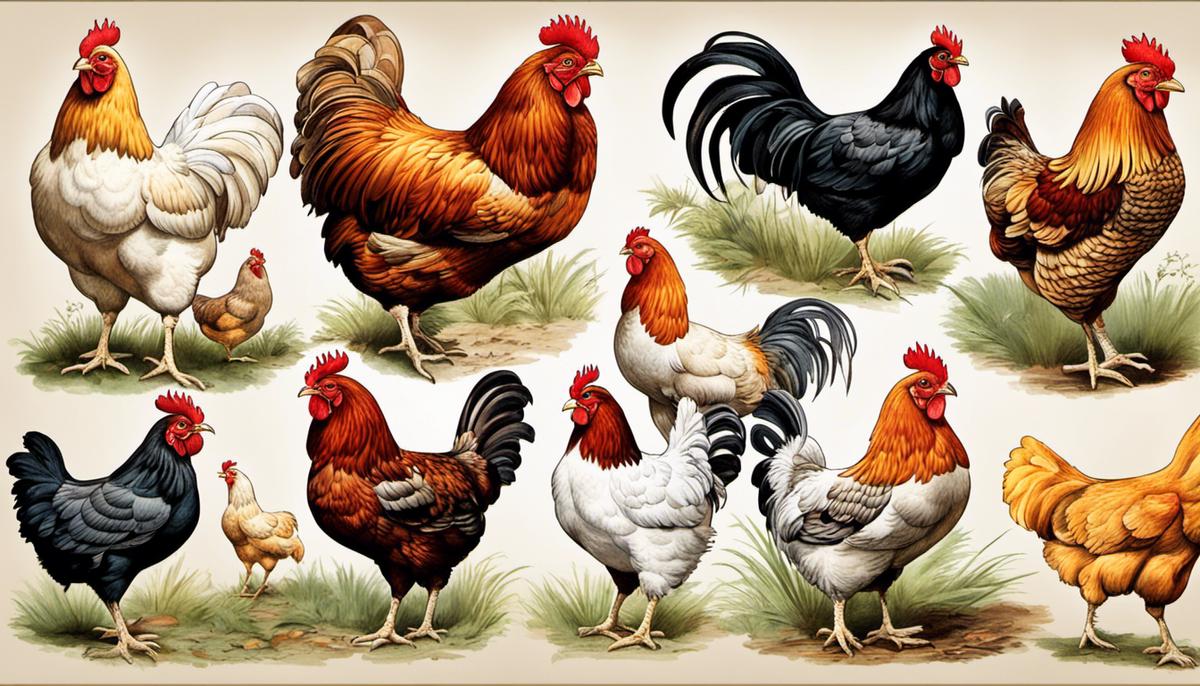Chicken farming has been a cornerstone of agriculture for centuries, providing a vital source of protein through meat and eggs. However, the success of a chicken farm goes beyond just having chickens; it begins with choosing the ideal breed of chicken that fits perfectly with your farming goals, location, and management practices. Getting informed on the fundamentals of chicken breeding, understanding the connection between farm objectives and breed selection, and recognizing the impact of climate on poultry farming, are key factors that determine a chicken farm’s productivity, profitability, and sustainability. Additionally, anticipating and preparing for each breed’s unique care and management requirements, as well as aligning your choices with market demand, can tip the scales in favor of farm success.
We will receive a commission if you purchase through our affiliate link at no extra cost to you. Please read our disclosure policy for more information.
Understanding the Basics of Chicken Breeding
Chicken Breeding: The Nuts and Bolts
Every hobbyist knows that a gratifying journey begins with understanding the basics. Chicken breeding, while an undeniably rewarding venture, requires an intricate balance of knowledge and practice. So, gear up fellow hobby-farmer! Let’s dive into the wonder-filled world of chicken breeding, and uncover the pillars that construct this exciting hobby.
First, let’s talk breeds. There are over 500 breeds of chickens worldwide, each with unique traits and characteristics. Different breeds are suitable for diverse breeding goals – be it egg-laying capacity, meat production, or unique physical traits. Therefore, familiarization with a variety of chicken breeds is invaluable for setting meaningful breeding goals.
Now, onto the bird’s reproductive system. While the mechanics may resemble other birds, chickens possess a few unique characteristics. Most chickens are not seasonal breeders, making year-round breeding possible. The hen’s ovulation is essentially an outcome of light perception — an increase in daylight stimulates egg production. Mating, on the other hand, is a dance in itself, marked by a mesmerizing courtship display from the rooster.
Understanding genetics kick-starts the real breed manipulation. Genetic traits in chickens, like feather color, size, and comb type can be predicted to an extent, by employing Punnett squares and genetic calculators. This knowledge enables breeders to produce offspring with desired traits while enhancing the overall flock diversity.
Hatching
Of course, no talk of chicken breeding would be complete without mentioning incubation. After the egg is fertilized, it’s a race against time to provide a precisely controlled environment for the embryo development. Optimum temperature and humidity play crucial roles during this three-week period. Whether using a broody hen or an artificial incubator, careful management is the secret to hatching success. For more information on raising baby chicks, check out my Article: Raising baby chicks: 101 your complete guide
Post-incubation, chick care becomes the focus. Providing a warm, nourished environment is critical for the prevention of common chick illnesses. Feeding high-protein starter feed, ensuring clean water and maintaining consistent temperature, mark the cornerstone of chick rearing.

While chicken breeding may seem like a daunting hobby at first glance, the thrills of witnessing a successful hatch, nurturing robust chicks, and elevating the flock quality, more than make up for the challenges faced. Safe to say, hobby-farmers who delve into chicken breeding will quickly find it to be much more than just a pastime – it is an endless exploration of life’s most extraordinary events, right from their backyard! There goes the saying, one does not simply breed chickens; they nurture life, generation after generation. And frankly, what could be more inspiring?
This Book shows you how to incubate, hatch, and brood baby chickens, ducklings, goslings, turkey poults, and guinea keets. With advice on everything from selecting a breed and choosing the best incubator to feeding and caring for newborn chicks in a brooder, this comprehensive guide also covers issues like embryo development, panting chicks, and a variety of common birth defects. Whether you want to hatch three eggs or one hundred, you’ll find all the information you need to make your poultry-raising operation a success.
Determining the Purpose of Your Chicken Farm
Picking the Perfect Pullet: How Your Chicken Farm’s Purpose Guides Breed Selection
When embarking on the exciting journey of chicken farming, one of the most crucial decisions to be made lies in the selection of chicken breeds. Amidst a myriad of chicken varieties, determining the right breed can be tough, and paradoxically, it’s precisely this variety that can guide you in making the right choice.
It’s important to remember that chicken breeds were historically developed to serve different purposes. While some are known for their exceptional egg-laying abilities, others are sought after for their meat quality. Some breeds boast both traits, earning them the badge of “dual-purpose” chickens. Conversely, unique breeds like the showy Silkies or vibrant Polish tend to be ornamental breeds, designed for aesthetics rather than utility.
But how does the intended purpose of the chicken farm guide your breed selection? Here’s the scoop…
If it’s eggs you’re after, then a breed like the White Leghorn would be an eggcellent choice. Leghorns are prolific egg-layers, known to produce upwards of 280 white eggs per year. Other notable egg-laying breeds include the Sussex and Rhode Island Red, both laying beautiful brown eggs. To learn more about raising chickens for eggs consider reading my Article: Raising Chickens For Eggs: A Beginners Guide.
On the other hand, if your venture leans towards poultry meat, consider the Cornish Cross. With their rapid growth and meaty physique, these birds are a staple in commercial meat production. Or perhaps consider the Jersey Giant, a breed that comfortably lives up to its name with its impressive size and meat quality.
Those seeking a balance between eggs and meat should look to dual-purpose breeds. The quintessential choice is the Plymouth Rock (also known as Barred Rock) — an adaptable breed with relaxed temperament, known to provide a fair supply of brown eggs and a reasonable amount of meat. Other notable dual-purpose breeds include the Australorp and the Orpington.
Fancy Bird
Now, if your farm leans towards ornamental purposes, then breeds like the Silkie, with its soft, fluffy plumage or the Polish, renowned for its feathered head crest, make excellent picks. These breeds are more about charm than performance, bringing a flair of beauty to any flock.
However you plan to operate your chicken farm, remember that breed selection is crucial. Not only will it impact the productivity of your flock, but it can also enhance or hinder your enjoyment of chicken farming. Picking the right breed is about identifying your farm’s purpose, considering the strengths and unique traits of different chicken breeds, and matching them accordingly. So take the time, make your choice wisely, and watch as your poultry passion pays off in countless eggs, hefty birds, or the joy of feathery companionship.

Climate Considerations in Poultry Farming
The impact of geographical location and local climate on your chicken breed choice can’t be overstated. Chickens are as multi-dimensional as the people who love and care for them. Just like their human caretakers, they too thrive in certain climates better than others. Their breed, their biology, their temperament—all intricately linked with the natural world around them. Hence, chicken breed selection, for the informed chicken farmer, is an art that synchronizes these factors together.
Knowing the geographical location matters when it comes to climates and the resulting chicken breeds that can be sustained in those climates. Some breeds are more hardy, adaptable to Cold climates—think of the Chantecler, the Canadian chicken breed specifically developed to thrive in extremely cold temperatures. Then there are breeds such as the Hamburg that do particularly well in hot climates. Understanding this intricate dance of climate adaptation is key to the health and productivity of your flock. To learn more about raising chickens in cold climates read my Article: 10 Things Beginner Chicken Keepers Must Know About Winter Safety.
Climate impacts the distribution of feed resources, which in turn affects the breed choice. Hardy, foraging breeds like the Jersey Giants, need space to roam and dig, making them ideal for rural or spacious suburban environments. But in urban neighborhoods where outdoor space can be limited, compact and neighbor-friendly breeds like the Bantam might be more suited.
It’s also important to consider potential predators you might encounter. Chickens are a favorite snack for many wild animals—foxes, hawks, raccoons, and more. Depending on your local ecosystem, you might want to consider breeds that are more predator savvy like the Rhode Island Red or the Plymouth Rock, both of which are known for their alertness.
location
Your geographical location often dictates the local laws and regulations regarding rearing chickens. Some areas may have bans or limits on chicken rearing, often due to noise and hygiene concerns. So getting well-acquainted with these rules is a must before you embark on selecting your chicken breed.
Lastly, consider your local community and market demands. If in a location with a high demand for specialty eggs for example, heritage or rare breeds that lay unique or colorful eggs like the Araucana and the Easter Egger can be profitable and fulfilling choices.
Adopting a single breed or diversifying your flock with multiple breeds, as the old saying goes, is really “different strokes for different folks.” However the needle ultimately moves, it’s vital to respect the individual relationships we share with these lovable creatures. It’s all about finding that breed, or mix of breeds, that best align with your environmental factors and personal preferences. By tuning into the interplay of breed characteristics, local climate, and geographical influences, you can cultivate a thriving swarm of clucking wonders – making your chicken breeding endeavor both fruitful and enjoyable.
Remember, chicken rearing is as much about intuition as it is about information. Breed choice, guided by geographic and climatic considerations, is instrumental, but nothing beats hands-on experience, the joy of learning from the quirks of individual chickens, their behaviors and their unexpected surprises.

Care and Management of Selected Breeds
Diving deeper into the chicken world, it’s time to crack open the coop on the intricate aspects of care and management requirements tailored to the needs of various chicken breeds. Keep in mind that harmonizing the breed’s inherent qualities with the right management can hugely influence the chickens’ wellbeing and productivity, providing an enjoyable and successful chicken rearing experience.
Turning to egg-laying breeds first up, like the mighty White Leghorns, consistent layers that they are, require a quality pellet diet to maintain their impressive output. They also benefit from a spacious run as they’re an active breed. A lesser known fact about Sussex chickens is their need for frequent dust baths to keep parasites at bay, along with a balanced diet full of greens and grains to sustain their dual-purpose nature.
Chart a different course with meat-producing breeds. The Cornish Cross, a fast-growing powerhouse, demands a high protein diet for optimal muscle development. Plus, regular health checks are critical due to their rapid weight gain which can cause health issues. Jersey Giants, on the other hand, being slower to mature, they need a steady diet over a longer period.
When you have Plymouth Rock or Australorp, representatives of dual-purpose breeds, you’ve got an all-weather champion. They’re hardy and adaptable, but maintaining a clean and dry environment goes a long way in preventing common diseases.
Fancy Birds

Delicate and often eccentric, ornamental breeds like Silkies and Polish chickens come with a unique set of requirements. Silkies, with their fluffy plumage, are more susceptible to parasites and may need more frequent checks. Both breeds appreciate a secure, low-rooster environment as they’re often at the bottom of the pecking order.
Imagine a classroom with Cochins or Brahmas! These gentle giants, often used for educational purposes, are robust, cold-tolerant breeds, but their feathered legs might require extra care to prevent mites and lice.
When it comes to weather, remember that local climates play a major role in breed selection. For instance, cold-tolerant breeds like the Plymouth Rock thrive in colder climates, while a Leghorn would do much better in warmer regions. Caring means providing shaded areas during extreme summer heat and insulating the coop in icy winters.
Don’t forget to review local regulations before getting started, ensuring the breed you choose aligns with community norms and market preferences. Whether you decide to stick with one breed or mix them up, understand that adaption to the local ecosystem, including potential predators, forms a vital part in managing chickens.
Respecting every chicken’s unique characteristics and preferences is crucial. Chickens, like us, have personalities and developing a keen eye for their individual behaviors helps in identifying and resolving potential issues early.
Thus, every step in the journey of chicken rearing, from breed to feed, is a fascinating blend of science, art, and passion. Making it not just a hobby, but a way of life, a means of connecting with nature on the fundamental level, while also delivering a dozen joy every day!

Profitability and Market Demand
Selecting the perfect chicken breed involves not only your personal taste but also looking at market dynamics. Poultry farming can be a profitable venture, and breed selection plays a significant role in determining your profitability. Market demand for various chicken products, as well as the profitability inherent in certain breeds, can effectively guide you towards a breed selection that results in more successful poultry farming.
On the egg-laying side, some breeds have been developed to be prolific egg producers, such as the White Leghorn or Sussex. These breeds often have a higher initial cost but can be more profitable due to the high volume of egg production. The eggs they provide are not just a source of food, but could also be sold, enabling one to recuperate costs faster. Local egg purchasing trends also influence their selection. If consumers in your area prefer brown eggs, you might lean towards Rhode Island Reds or Sussex, which are known for their delicious, brown-shelled eggs.
What About The Meat
When it comes to meat producers, breeds such as the Cornish Cross and Jersey Giant have been selectively bred for fast growth and substantial mass. People primarily select these breeds when their primary motive is to sell the meat. It’s important to gauge your market’s demand for chicken meat — whether customers prefer lean white meat, which the Cornish Cross excels at, or if they revel in the more flavorful dark meat, which breeds like the Jersey Giant are recognized for.
If you’re looking at dual-purpose breeds, Breeds like the Plymouth Rock or Australorp can provide value in terms of both egg-laying and meat. These can be especially profitable if you’re in an area looking for a diverse range of chicken products or if you don’t want to exclude egg or meat offerings. As they meet both egg and meat demands, they can be safer options when market trends fluctuate.
Ornamental breeds like the Silkie and Polish are a whole other ballgame. These breeds usually require an entirely different market that appreciates the breed’s unique aesthetics. People may buy them as pets or for exhibitions and shows. Thus, their market demands differ drastically, and the profitability comes from higher prices associated with their aesthetic appeal rather than egg or meat production.
Considering the market demand and profitability of chicken breeds helps ensure that your chicken farming venture will be successful and enjoyable. It’s always wise to ask which breeds the local community prefers. Somewhere, someone may be looking for a rare breed for educational purposes, therapeutic needs, or simply out of love for chickens. Catering to these demands can also fetch a higher price.
Conclusion
Finally, irrespective of the selected breed, remember that each chicken you bring into your home or farm has its individual quirks and attributes. Building a personal relationship with your chickens and providing them with the care, respect, and love they deserve is the essence of this rewarding hobby. Balancing market dynamics, checkbook insights, and personal enthusiasm leads to the most rewarding chicken rearing experience.

Remember, chicken farming, like other forms of agriculture, is far from being a one-size-fits-all endeavor. It requires careful thought, in-depth research, strategic decision-making, and dedicated management. The breed you choose for your chicken farm plays a significant role – affecting everything from the wealth of your farm to its future in the market. Those who take the time to understand the dynamics of breed selection in relation to their farming context are positioned for a rewarding experience – an optimized production, a sustainable operation, and a profitable business. So, let your knowledge of breeds, climate, care, and market trends pave the way for a successful chicken farm that will thrive for generations to come.
For more information on chicken breeds be sure to read my Article: Beginners Guide to Chickens breeds: An Informative Overview





